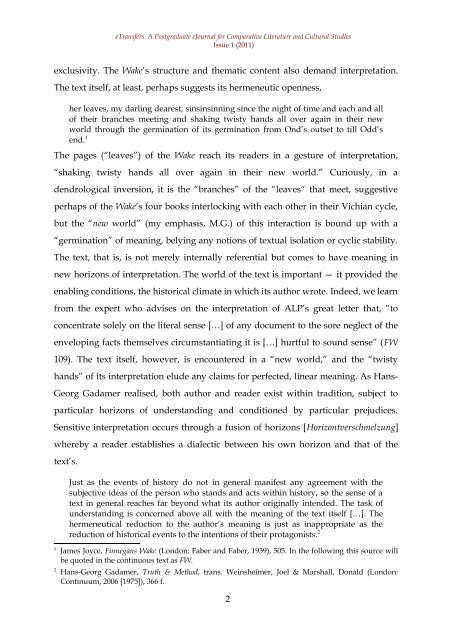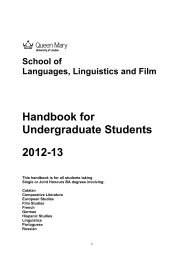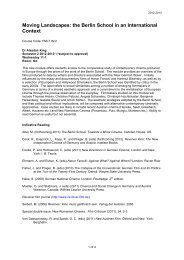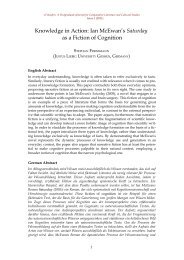Finnegans Wake - Queen Mary, University of London
Finnegans Wake - Queen Mary, University of London
Finnegans Wake - Queen Mary, University of London
You also want an ePaper? Increase the reach of your titles
YUMPU automatically turns print PDFs into web optimized ePapers that Google loves.
eTransfers. A Postgraduate eJournal for Comparative Literature and Cultural Studies<br />
Issue 1 (2011)<br />
exclusivity. The <strong>Wake</strong>’s structure and thematic content also demand interpretation.<br />
The text itself, at least, perhaps suggests its hermeneutic openness,<br />
her leaves, my darling dearest, sinsinsinning since the night <strong>of</strong> time and each and all<br />
<strong>of</strong> their branches meeting and shaking twisty hands all over again in their new<br />
world through the germination <strong>of</strong> its germination from Ond’s outset to till Odd’s<br />
end. 1<br />
The pages (“leaves”) <strong>of</strong> the <strong>Wake</strong> reach its readers in a gesture <strong>of</strong> interpretation,<br />
“shaking twisty hands all over again in their new world.” Curiously, in a<br />
dendrological inversion, it is the “branches” <strong>of</strong> the “leaves“ that meet, suggestive<br />
perhaps <strong>of</strong> the <strong>Wake</strong>’s four books interlocking with each other in their Vichian cycle,<br />
but the “new world” (my emphasis, M.G.) <strong>of</strong> this interaction is bound up with a<br />
“germination” <strong>of</strong> meaning, belying any notions <strong>of</strong> textual isolation or cyclic stability.<br />
The text, that is, is not merely internally referential but comes to have meaning in<br />
new horizons <strong>of</strong> interpretation. The world <strong>of</strong> the text is important — it provided the<br />
enabling conditions, the historical climate in which its author wrote. Indeed, we learn<br />
from the expert who advises on the interpretation <strong>of</strong> ALP’s great letter that, “to<br />
concentrate solely on the literal sense […] <strong>of</strong> any document to the sore neglect <strong>of</strong> the<br />
enveloping facts themselves circumstantiating it is […] hurtful to sound sense” (FW<br />
109). The text itself, however, is encountered in a “new world,” and the “twisty<br />
hands” <strong>of</strong> its interpretation elude any claims for perfected, linear meaning. As Hans-<br />
Georg Gadamer realised, both author and reader exist within tradition, subject to<br />
particular horizons <strong>of</strong> understanding and conditioned by particular prejudices.<br />
Sensitive interpretation occurs through a fusion <strong>of</strong> horizons [Horizontverschmelzung]<br />
whereby a reader establishes a dialectic between his own horizon and that <strong>of</strong> the<br />
text’s.<br />
Just as the events <strong>of</strong> history do not in general manifest any agreement with the<br />
subjective ideas <strong>of</strong> the person who stands and acts within history, so the sense <strong>of</strong> a<br />
text in general reaches far beyond what its author originally intended. The task <strong>of</strong><br />
understanding is concerned above all with the meaning <strong>of</strong> the text itself […]. The<br />
hermeneutical reduction to the author’s meaning is just as inappropriate as the<br />
reduction <strong>of</strong> historical events to the intentions <strong>of</strong> their protagonists. 2<br />
1 James Joyce, <strong>Finnegans</strong> <strong>Wake</strong> (<strong>London</strong>: Faber and Faber, 1939), 505. In the following this source will<br />
be quoted in the continuous text as FW.<br />
2 Hans-Georg Gadamer, Truth & Method, trans. Weinsheimer, Joel & Marshall, Donald (<strong>London</strong>:<br />
Continuum, 2006 [1975]), 366 f.<br />
2







